Probabilistic Cascade Modeling for Enhanced Flood and Landslide Hazard Assessment: Integrating Multi-Model Approaches in the La Liboriana River Basin
Abstract
:1. Introduction
2. Study Area and Flash-Flooding Historical Event
3. Materials and Methods
3.1. Spatial Rainfall Intensities
3.2. Landslide Hazard Assessment Using Slope–Infiltration–Distributed Equilibrium (SLIDE) Model
3.3. Landslide Propagation and Deposition Height Modeling Using the Rapid Mass Movement Simulation (RAMMS) Software
3.4. Probabilistic Torrential Flood Hazard Zonation
4. Results
4.1. Spatial Rainfall Intensities for Each Return Period
4.2. Landslide Hazard Assessment
4.3. Landslide Propagation and Probabilistic River Channel Obstructions
4.4. Hydrologic and Hydraulic Modeling
4.5. Probabilistic Torrential Flood Hazard Zonation Results
5. Discussion
6. Conclusions
Author Contributions
Funding
Data Availability Statement
Acknowledgments
Conflicts of Interest
References
- Mergili, M.; Marchant Santiago, C.I.; Moreiras, S.M. Causas, características e impacto de los procesos de remoción en masa, en áreas contrastantes de la región Andina. Cuad. De Geogr. Rev. Colomb. De Geogr. 2015, 24, 113–131. [Google Scholar] [CrossRef]
- UNGRD. Consultoría de los Estudios de Diseño del Sistema de Alerta Temprana para Avenidas Torrenciales y Crecientes Súbitas Generadas por Precipitaciones de la Microcuenca de los Ríos Mulato, Sangoyaco, Quebradas Taruca y Taruquita del Municipio de Mocoa, en el Marco de las Declaratorias de Calamidad Pública y Desastre del Municipio de Mocoa, Putumayo, Debidas al Evento Presentado el 31 de marzo de 2017. Ed. Pontificia Universidad Javeriana. 2018. Available online: http://repositorio.gestiondelriesgo.gov.co/handle/20.500.11762/27207 (accessed on 23 May 2023).
- García-Delgado, H.; Villamizar-Escalante, N.; Bermúdez, M.A.; Bernet, M.; Velandia, F. Climate or tectonics? What controls the spatial-temporal variations in erosion rates across the Eastern Cordillera of Colombia? Glob. Planet. Chang. 2021, 203, 103541. [Google Scholar] [CrossRef]
- UNGRD. Consolidado de Emergencias. Unidad Nacional para la Gestión de Riesgo de Desastres. 2024. Available online: https://www.datos.gov.co/Ambiente-y-Desarrollo-Sostenible/Emergencias-UNGRD-/wwkg-r6te/about_data (accessed on 22 August 2024).
- SGC. Inventario de Movimientos en Masa. Servicio Geológico Colombiano-SCG. 2024. Available online: https://datos.sgc.gov.co/datasets/312c8792ddb24954a9d2711bd89d1afe_0/explore?location=4.662548%2C-74.666269%2C5.61 (accessed on 22 August 2024).
- SGC. SIMMA-Sistema de Información de Movimientos en Masa. Servicio Geológico Colombiano-SCG. 2024. Available online: https://simma.sgc.gov.co/#/ (accessed on 22 August 2024).
- Velásquez, N.; Hoyos, C.; Vélez, J.; Zapata, E. Reconstructing the Salgar 2015 Flash Flood Using Radar Retrievals and a Conceptual Modeling Framework: A Basis for a Better Flood Generating Mechanisms Discrimination. Hydrol. Earth Syst. Sci. 2018, 24, 1367–1392. [Google Scholar] [CrossRef]
- Hidalgo, C.A.; Vega, J.A. Probabilistic landslide risk assessment in water supply basins: La Liboriana River Basin (Salgar-Colombia). Nat. Hazards 2021, 109, 273–301. [Google Scholar] [CrossRef]
- Cheng, D.; Cui, Y.; Su, F.; Jia, Y.; Choi, C.E. The characteristics of the Mocoa compound disaster event, Colombia. Landslides 2018, 15, 1223–1232. [Google Scholar] [CrossRef]
- García-Delgado, H.; Machuca, S.; Medina, E. Dynamic and geomorphic characterizations of the Mocoa debris flow (March 31, 2017, Putumayo Department, southern Colombia). Landslides 2019, 16, 597–609. [Google Scholar] [CrossRef]
- Naranjo, K.; Aristizábal, E.; Palacio, J. Morphological characteristics of drainage networks related to landslide cluster in the Colombian Andean. E3S Web Conf. 2023, 415, 05015. [Google Scholar] [CrossRef]
- Avila-Suárez, S.D. Clima en Movimiento: Análisis de la Influencia del Chorro del Orinoco y ENOS Sobre Los Movimientos en Masa en el Piedemonte Llanero. 2024. Available online: https://hdl.handle.net/1992/74481 (accessed on 21 July 2024).
- Thomas, J.; Gupta, M.; Srivastava, P.K.; Petropoulos, G.P. Assessment of a Dynamic Physically Based Slope Stability Model to Evaluate Timing and Distribution of Rainfall-Induced Shallow Landslides. ISPRS Int. J. Geo-Inf. 2023, 12, 105. [Google Scholar] [CrossRef]
- Arghya, A.B.; Hawlader, B.; Guthrie, R.H. A Comparison of Two Runout Programs for Debris Flow Assessment at the Solalex-Anzeindaz Region of Switzerland., in Géorisques—VIII—Geohazards, (Quebec, Canada). 2022. Available online: https://www.stantec.com/en/ideas/a-comparison-of-two-runout-programs-for-debris-flow-assessment-solalex-anzeindaz-region-switzerland (accessed on 1 May 2023).
- Trujillo-Vela, M.G.; Ramos-Cañón, A.M.; Escobar-Vargas, J.A.; Galindo-Torres, S.A. An overview of debris-flow mathematical modelling. Earth-Sci. Rev. 2022, 232, 104135. [Google Scholar] [CrossRef]
- Aristizábal, E.; Arango Carmona, M.I.; García López, I.K.; Aristizábal, E.; Arango Carmona, M.I.; García López, I.K. Definición y clasificación de las avenidas torrenciales y su impacto en los Andes colombianos. Cuad. De Geogr. Rev. Colomb. De Geogr. 2020, 29, 242–258. [Google Scholar] [CrossRef]
- Dayán, M.; Bautista, P. Definición del Estado del Arte de las Metodologías de Evaluación de Amenaza por Avenidas Torrenciales en Algunos Países de la Zona Intertropical. 2017. Available online: https://repositorio.uptc.edu.co//handle/001/2240 (accessed on 28 March 2024).
- Acero, J.S. Predicción de Flujos de Detritos Detonados por Lluvias Extremas Mediante Exportación de Modelos Estocásticos: Aplicación en la Cuenca de la Quebrada Grande (Labranzagrande-Boyacá, Colombia). Tesis o Trabajo de Investigación Presentada(o) Como Requisito Parcial para Optar al Título de Magíster en Geología. Master Dissertation, Universidad Nacional de Colombia, Bogotá, Colombia, 2019. [Google Scholar]
- Rodríguez, E.A.; Sandoval, J.H.; Chaparro, J.L.; Trejos, G.A.; Medina, E.; Ramirez, K.; Castro, E.; Castro, J.A.; Ruiz, G. Guía metodológica para la zonificación de amenaza por movimientos en masa escala 1:25,000. Libros Del Serv. Geológico Colomb. 2017; ISBN 978-958-59782-2-5. [Google Scholar] [CrossRef]
- Hungr, O.; Evans, S.G.; Bovis, M.J.; Hutchinson, J.N. A review of the classification of landslides of the flow type. Environ. Eng. Geosci. 2001, 7, 221–238. [Google Scholar] [CrossRef]
- Ramos, A.M.; Reyes, A.A.; Munévar, M.A.; Ruiz, G.L.; Machuca, S.V.; Rangel, M.S.; Prada, L.F.; Cabrera, M.Á.; Rodríguez, C.E.; Escobar, N.; et al. Guía Metodológica para Zonificación de Amenaza por Avenidas Torrenciales. In Libros del Servicio Geológico Colombiano, 1st ed.; Servicio Geológico Colombiano y Pontificia Universidad Javeriana: Bogotá, Colombia, 2021; Volume 1. [Google Scholar] [CrossRef]
- Li, C.; Wang, M.; Chen, F.; Coulthard, T.; Wang, L. Integrating the SLIDE model within CAESAR-Lisflood: Modeling the ‘rainfall-landslide-flash flood’ disaster chain mechanism under landscape evolution in a mountainous area. Catena 2023, 227, 107124. [Google Scholar] [CrossRef]
- Hong, M.; Jeong, S.; Kim, J. A combined method for modeling the triggering and propagation of debris flows. Landslides 2020, 17, 805–824. [Google Scholar] [CrossRef]
- Hidalgo, C.A.; Vega, J.A.; Obando, M.P. Effect of the Rainfall Infiltration Processes on the Landslide Hazard Assessment of Unsaturated Soils in Tropical Mountainous Regions. In Engineering and Mathematical Topics in Rainfall; BoD–Books on Demand: Norderstedt, Germany, 2018. [Google Scholar] [CrossRef]
- Bocanegra, R.A.; Ramírez, C.A.; Salcedo, E.d.J.; Villegas, M.P.L. Determination of Hazard Due to Debris Flows. Water 2023, 15, 4057. [Google Scholar] [CrossRef]
- Owolabi, T.A.; Sajjad, M. A global outlook on multi-hazard risk analysis: A systematic and scientometric review. Int. J. Disaster Risk Reduct. 2023, 92, 103727. [Google Scholar] [CrossRef]
- Laino, E.; Paranunzio, R.; Iglesias, G. Scientometric review on multiple climate-related hazards indices. Sci. Total. Environ. 2024, 945, 174004. [Google Scholar] [CrossRef]
- Dunant, A.; Bebbington, M.; Davies, T. Probabilistic cascading multi-hazard risk assessment methodology using graph theory, a New Zealand trial. Int. J. Disaster Risk Reduct. 2021, 54, 102018. [Google Scholar] [CrossRef]
- Yao, S.; Lei, Y.; Liu, D.; Cheng, D. Assessment risk of evolution process of disaster chain induced by potential landslide in Woda. Nat. Hazards 2024, 120, 677–700. [Google Scholar] [CrossRef]
- Marin, R.J.; Velásquez, M.F.; Sánchez, O. Applicability and performance of deterministic and probabilistic physically based landslide modeling in a data-scarce environment of the Colombian Andes. J. S. Am. Earth Sci. 2021, 108, 103175. [Google Scholar] [CrossRef]
- Aristizábal-Giraldo, E.V.; Ruiz-Vásquez, D. Landslide susceptibility assessment in scarce-data regions using remote sensing data. Rev. Fac. De Ing. Univ. De Antioq. 2024, 45–59. [Google Scholar] [CrossRef]
- Vega, J.; Hidalgo, C. Comparison study of a landslide-event hazard mapping using a multi-approach of fuzzy logic, TRIGRS model, and support vector machine in a data-scarce Andes Mountain region. Arab. J. Geosci. 2023, 16, 527. [Google Scholar] [CrossRef]
- Hoyos, C.D.; Ceballos, L.I.; Pérez-Carrasquilla, J.S.; Sepúlveda, J.; López-Zapata, S.M.; Zuluaga, M.D.; Velásquez, N.; Herrera-Mejía, L.; Hernández, O.; Guzmán-Echavarría, G.; et al. Meteorological conditions leading to the 2015 Salgar flash flood: Lessons for vulnerable regions in tropical complex terrain. Nat. Hazards Earth Syst. Sci. 2019, 19, 2635–2665. [Google Scholar] [CrossRef]
- Liao, Z.; Hong, Y.; Wang, J.; Fukuoka, H.; Sassa, K.; Karnawati, D.; Fathani, F. Prototyping an experimental early warning system for rainfall-induced landslides in Indonesia using satellite remote sensing and geospatial datasets. Landslides 2010, 7, 317–324. [Google Scholar] [CrossRef]
- Bartelt, P.; Claudia, B.; Yves, B.; Marc, C.; Yolanda, D.; Christoph, G.; Brian, M.; Maren, S.; Maike, S. RAMMS::DEBRISFLOW User Manual. A Numerical Model for Debris Flows in Research and Practice. 2017. Available online: http://8107439.s21d-8.faiusrd.com/61/ABUIABA9GAAg28Lk9AUo_K6WjAM.pdf (accessed on 22 August 2024).
- Bladé, E.; Cea, L.; Corestein, G.; Escolano, E.; Puertas, J.; Vázquez-Cendón, E.; Dolz, J.; Coll, A. Iber—River modelling simulation tool. Rev. Int. De Métodos Numéricos Para Cálculo Y Diseño En Ing. 2014; 30, 1–10. [Google Scholar] [CrossRef]
- Francés, F.; Vélez, J.I.; Vélez, J.J. Split-parameter structure for the automatic calibration of distributed hydrological models. J. Hydrol. 2007, 332, 226–240. [Google Scholar] [CrossRef]
- Velásquez, N.; Hoyos, C.D.; Vélez, J.I.; Zapata, E. Reconstructing the 2015 Salgar flash flood using radar retrievals and a conceptual modeling framework in an ungauged basin. Hydrol. Earth Syst. Sci. 2020, 24, 1367–1392. [Google Scholar] [CrossRef]
- Sepúlveda Berrío, J. Estimación Cuantitativa de Precipitación a Partir de la Información de Radar Meteorológico del Área Metropolitana del Valle de Aburrá. Doctoral Dissertation, Universidad Nacional de Colombia, Bogotá, Colombia, 2016. [Google Scholar]
- Sepúlveda, J.; Hoyos Ortiz, C.D.; Sepúlveda, J.; Hoyos Ortiz, C.D. Disdrometer-based C-Band Radar Quantitative Precipitation Estimation (QPE) in a highly complex terrain region in tropical Colombia. In AGU Fall Meeting Abstracts; 2017; Volume 2017, A31A–2157. Available online: https://ui.adsabs.harvard.edu/abs/2017AGUFM.A31A2157S/abstract (accessed on 17 July 2024).
- Li, W.; Liu, C.; Hong, Y.; Saharia, M.; Sun, W.; Yao, D.; Chen, W. Rainstorm-induced shallow landslides process and evaluation—A case study from three hot spots, China. Geomat. Nat. Hazards Risk 2016, 7, 1908–1918. [Google Scholar] [CrossRef]
- Murgia, I.; Giadrossich, F.; Mao, Z.; Cohen, D.; Capra, G.F.; Schwarz, M. Modeling shallow landslides and root reinforcement: A review. Ecol. Eng. 2022, 181, 106671. [Google Scholar] [CrossRef]
- Vega, J.A.; Hidalgo, C.A. Quantitative risk assessment of landslides triggered by earthquakes and rainfall based on direct costs of urban buildings. Geomorphology 2016, 273, 217–235. [Google Scholar] [CrossRef]
- Li, Y.; Chen, J.; Zhou, F.; Song, S.; Zhang, Y.; Gu, F.; Cao, C. Identification of ancient river-blocking events and analysis of the mechanisms for the formation of landslide dams in the Suwalong section of the upper Jinsha River, SE Tibetan Plateau. Geomorphology 2020, 368, 107351. [Google Scholar] [CrossRef]
- Montrasio, L.; Valentino, R.; Losi, G.L.; Corina, A.; Rossi, L.; Rudari, R. Space-time hazard assessment of rainfall-induced shallow landslides. Landslide Sci. Pract. Glob. Environ. Change 2013, 4, 283–293. [Google Scholar] [CrossRef]
- Montrasio, L.; Valentino, R. A model for triggering mechanisms of shallow landslides. Nat. Hazards Earth Syst. Sci. 2008, 8, 1149–1159. [Google Scholar] [CrossRef]
- Oliveira, S.C.; Zêzere, J.L.; Lajas, S.; Melo, R. Combination of statistical and physically based methods to assess shallow slide susceptibility at the basin scale. Nat. Hazards Earth Syst. Sci. 2017, 17, 1091–1109. [Google Scholar] [CrossRef]
- Fernandes Azevedo, G.; Montoya Botero, E.; Martínez, H.; García, E.; Moreira de Souza, N. Estimativa da Profundidade do solo pelo uso de Técnicas de Geoprocessamento, Estudo de caso: Setor Pajarito, Colômbia. In XVII Brazilian Symposium on Remote Sensing. 2015. Available online: https://www.researchgate.net/publication/292145478_Estimativa_da_profundidade_do_solo_pelo_uso_de_tecnicas_de_geoprocessamento_estudo_de_caso_Setor_Pajarito_Colombia#fullTextFileContent (accessed on 7 May 2023).
- Montoya Botero, E. Metodologia Para Aplicação de Redes Neurais Artificiais para Sistemas de Alerta de Escorregamentos Deflagrados por Chuvas em Regiões Montanhosas. 2018. Available online: https://repositorio.unb.br/handle/10482/33056 (accessed on 7 May 2023).
- Náquira Bazán, M.V. Susceptibilidad de Remociones en Masa en las Costas de Fiordos Cercanos a Hornopirén, X Región. 2009. Available online: https://repositorio.uchile.cl/handle/2250/103473 (accessed on 7 May 2023).
- Glaus, J.; Jones, K.W.; Bühler, Y.B.; Christen, M.; Ruttner-Jansen, P.; Gaume, J.; Bartelt, P. RAMMS: Extended-Sensitivity Analysis of Numerical Fluidized Powder Avalanche Simulation In Three-Dimensional Terrain. In International Snow Science Workshop Proceedings; 2023; Bend, Oregon. Available online: https://www.dora.lib4ri.ch/wsl/islandora/object/wsl%3A35764/datastream/PDF/Glaus-2023-RAMMS-%28published_version%29.pdf (accessed on 22 August 2024).
- Roldán, F.; Salazar, I.; González, G.; Roldán, W.; Toro, N. Flow-Type Landslides Analysis in Arid Zones: Application in La Chimba Basin in Antofagasta, Atacama Desert (Chile). Water 2022, 14, 2225. [Google Scholar] [CrossRef]
- Sanz-Ramos, M.; Bladé, E.; Dolz, J.; Sánchez-Juny, M. Revisiting the Hydraulics of the Aznalcóllar Mine Disaster. Mine Water Environ. 2022, 41, 335–356. [Google Scholar] [CrossRef]
- Mikoš, M.; Bezak, N. Debris Flow Modelling Using RAMMS Model in the Alpine Environment With Focus on the Model Parameters and Main Characteristics. Front. Earth Sci. 2021, 8, 732. [Google Scholar] [CrossRef]
- Rogelis, M.C.; Werner, M.; Obregón, N.; Wright, N. Regional prioritisation of flood risk in mountainous areas. Nat. Hazards Earth Syst. Sci. 2016, 16, 833–853. [Google Scholar] [CrossRef]
- Pérez-Montiel, J.I.; Cardenas-Mercado, L.; Nardini, A.G.C. Flood Modeling in a Coastal Town in Northern Colombia: Comparing MODCEL vs. IBER. Water 2022, 14, 3866. [Google Scholar] [CrossRef]
- Hurtado, M.I. Análisis de Aplicabilidad y Desempeño de Modelos de Base Física Para la Modelación de Debris Flow en una Cuenca Tropical de Montaña. Master Dissertation, Universidad de Medellín, Medellín, Colombia, 2023. [Google Scholar]
- Huff, F.A. Time distribution of rainfall in heavy storms. Water Resour. Res. 1967, 3, 1007–1019. [Google Scholar] [CrossRef]
- Vega, J.; Sepúlveda-Murillo, F.H.; Parra, M. Landslide Modeling in a Tropical Mountain Basin Using Machine Learning Algorithms and Shapley Additive Explanations. Air Soil Water Res. 2023, 16, 11786221231195824. [Google Scholar] [CrossRef]

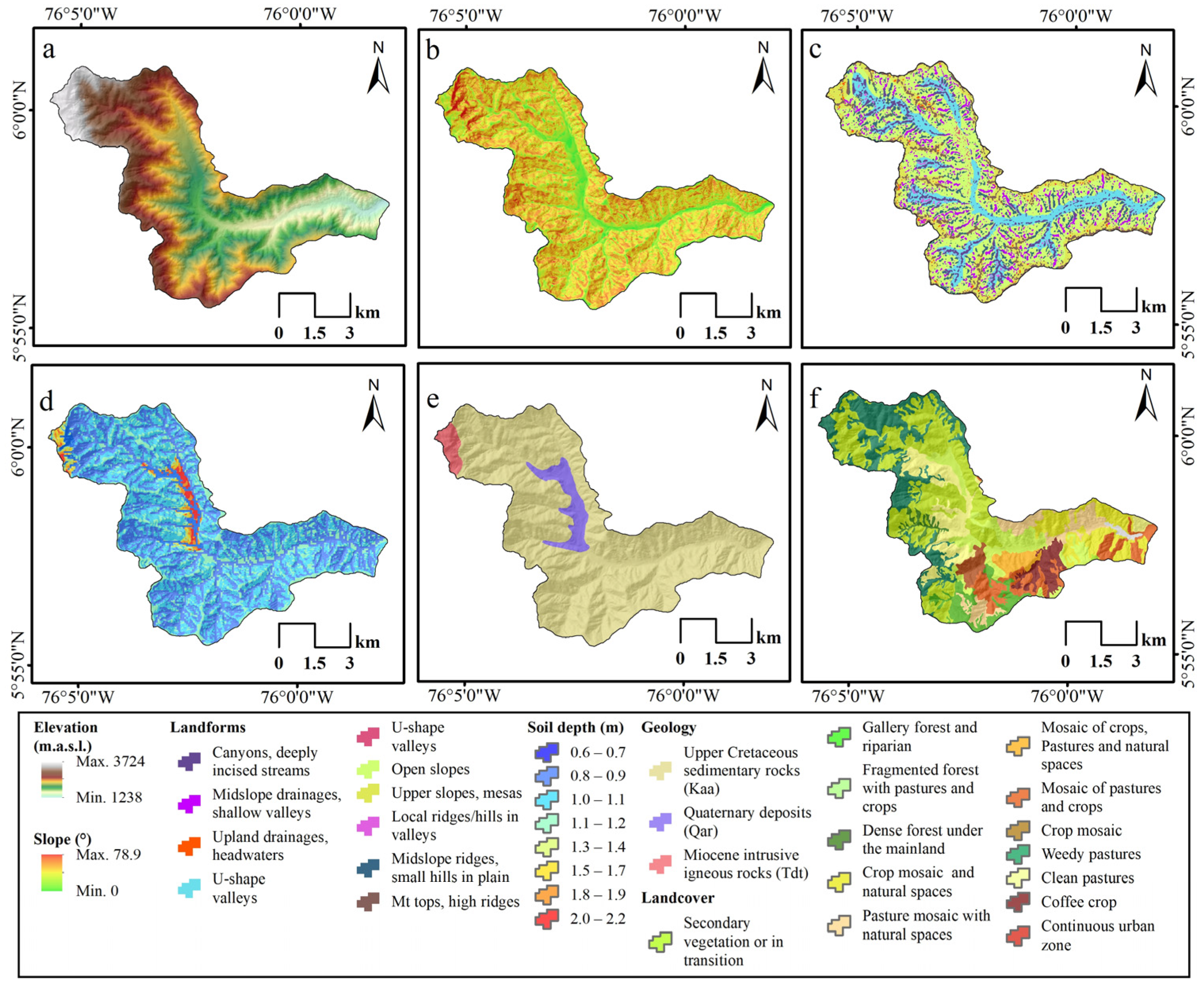

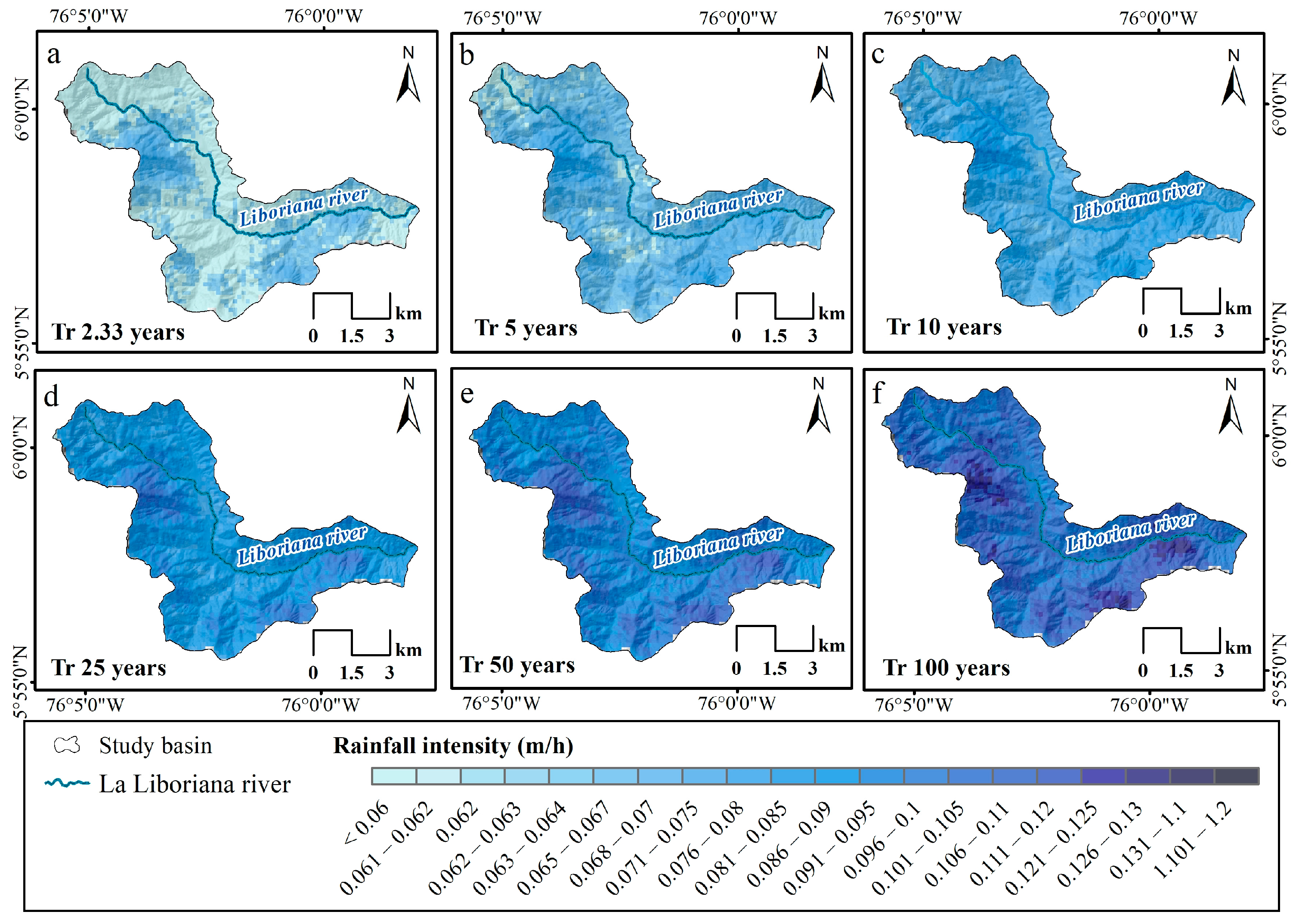




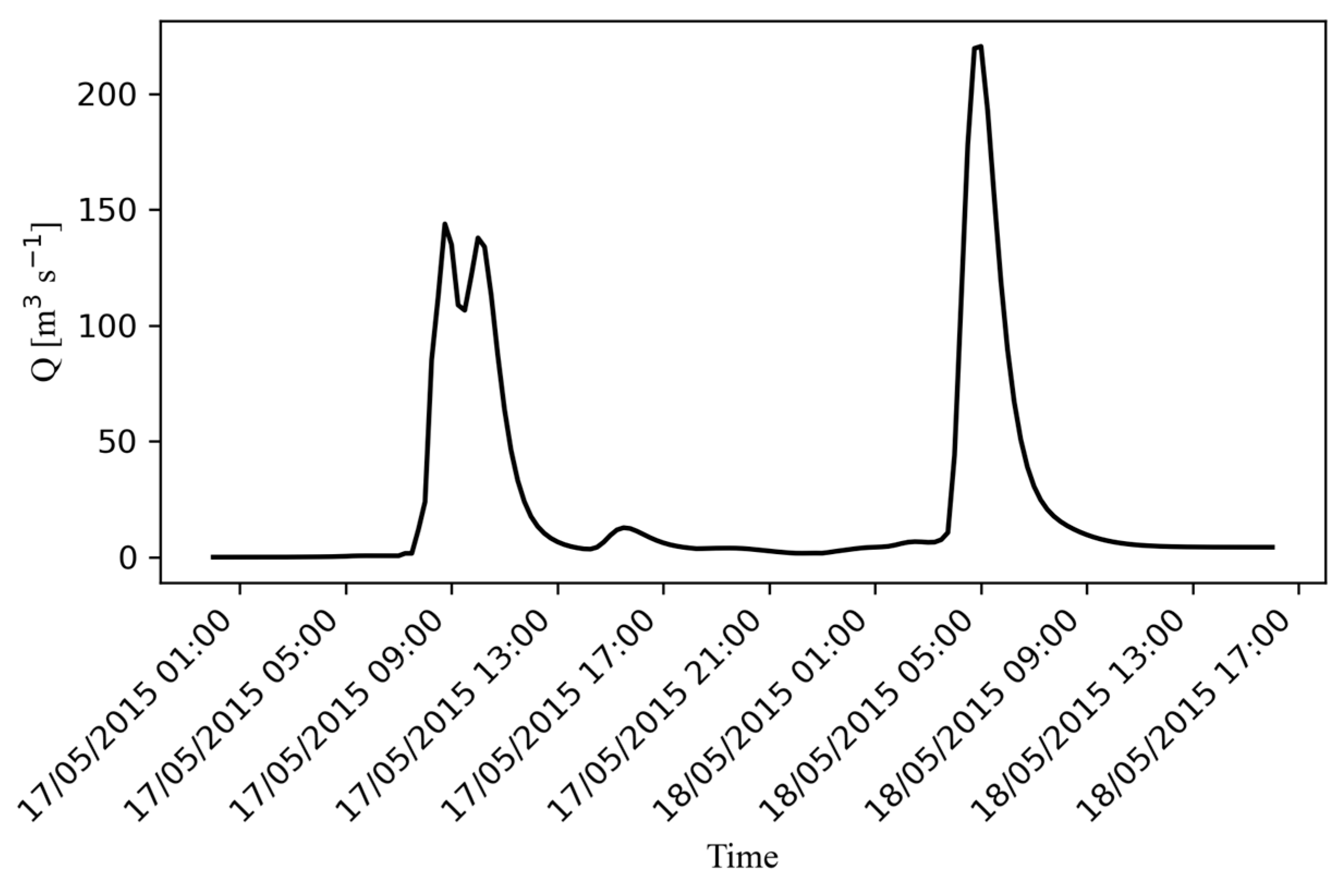
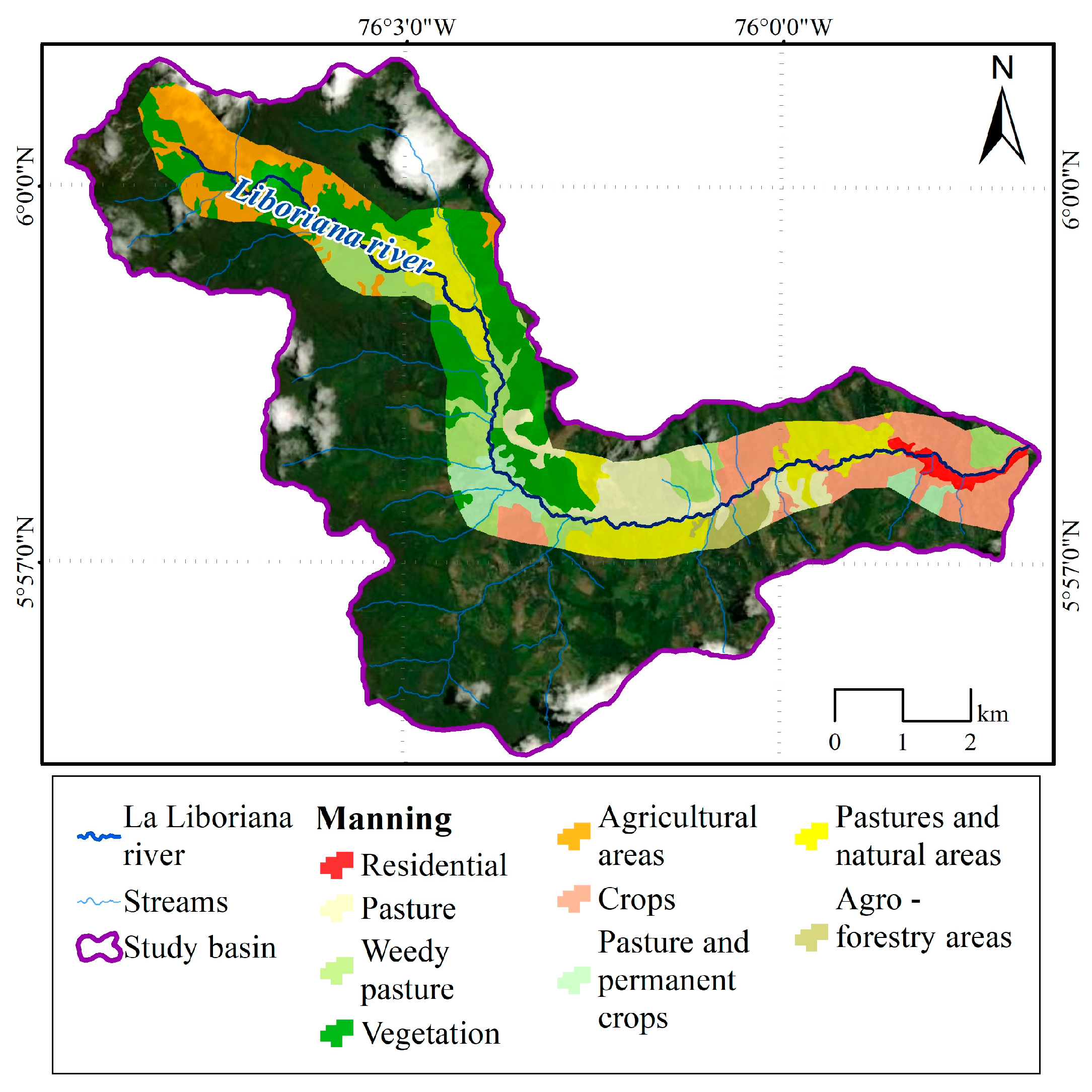

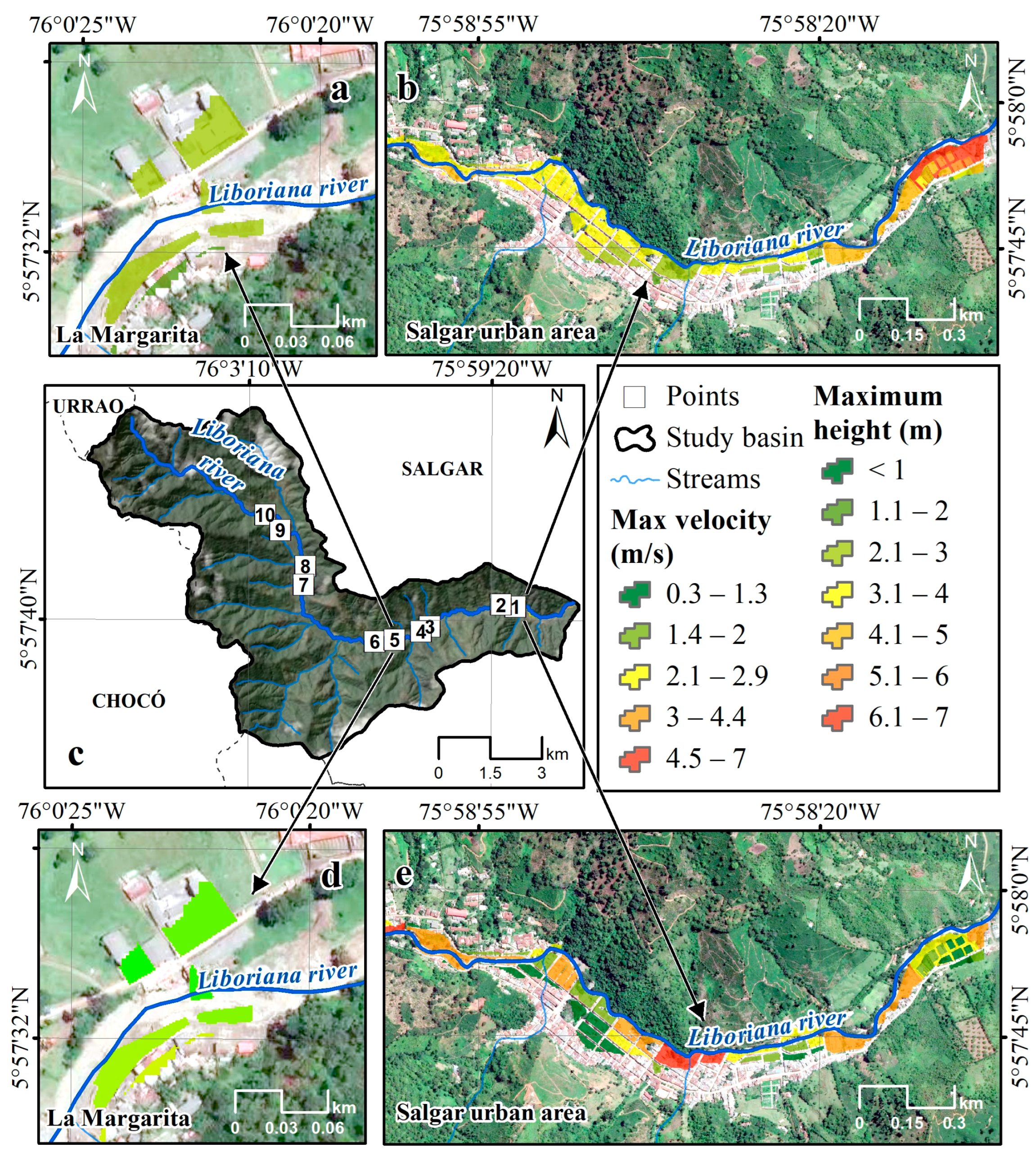

| Lithology | Nomenclature | C | ϕ | Gs | n | Sr | K |
|---|---|---|---|---|---|---|---|
| Upper cretaceous sedimentary rocks | Kaa | 10.5 | 24.0 | 2.68 | 0.40 | 65.0 | 3.98∙10−3 |
| Quaternary deposits | Qar | 18.0 | 30.0 | 2.65 | 0.39 | 70.0 | 1.80∙10−2 |
| Miocene intrusive igneous rocks | Tdt | 5.0 | 32.0 | 2.65 | 0.39 | 94.0 | 3.60∙10−2 |
| Simulation Site | Q Tr 5 [m3 s−1] | Q Tr 10 [m3 s−1] | Q Tr 25 [m3 s−1] | Q Tr 50 [m3 s−1] | Q Tr 100 [m3 s−1] | Torrential Flood Event |
|---|---|---|---|---|---|---|
| 1 | 1.9 | 2.6 | 3.2 | 3.7 | 4.1 | 12.05 |
| 2 | 1.1 | 1.9 | 3.3 | 4.3 | 5.3 | 22.6 |
| 4 | 0.03 | 0.03 | 0.072 | 0.3 | 0.7 | 20.4 |
| 5 | 0.03 | 0.03 | 0.03 | 0.3 | 1.8 | 36.6 |
| 8 | 0.04 | 0.2 | 1.7 | 3.01 | 5.1 | 26.9 |
| Outlet | 6.3 | 8.6 | 12.4 | 16.3 | 22.5 | 220.4 |
Disclaimer/Publisher’s Note: The statements, opinions and data contained in all publications are solely those of the individual author(s) and contributor(s) and not of MDPI and/or the editor(s). MDPI and/or the editor(s) disclaim responsibility for any injury to people or property resulting from any ideas, methods, instructions or products referred to in the content. |
© 2024 by the authors. Licensee MDPI, Basel, Switzerland. This article is an open access article distributed under the terms and conditions of the Creative Commons Attribution (CC BY) license (https://creativecommons.org/licenses/by/4.0/).
Share and Cite
Vega, J.; Ortiz-Giraldo, L.; Botero, B.A.; Hidalgo, C.; Parra, J.C. Probabilistic Cascade Modeling for Enhanced Flood and Landslide Hazard Assessment: Integrating Multi-Model Approaches in the La Liboriana River Basin. Water 2024, 16, 2404. https://doi.org/10.3390/w16172404
Vega J, Ortiz-Giraldo L, Botero BA, Hidalgo C, Parra JC. Probabilistic Cascade Modeling for Enhanced Flood and Landslide Hazard Assessment: Integrating Multi-Model Approaches in the La Liboriana River Basin. Water. 2024; 16(17):2404. https://doi.org/10.3390/w16172404
Chicago/Turabian StyleVega, Johnny, Laura Ortiz-Giraldo, Blanca A. Botero, César Hidalgo, and Juan Camilo Parra. 2024. "Probabilistic Cascade Modeling for Enhanced Flood and Landslide Hazard Assessment: Integrating Multi-Model Approaches in the La Liboriana River Basin" Water 16, no. 17: 2404. https://doi.org/10.3390/w16172404





